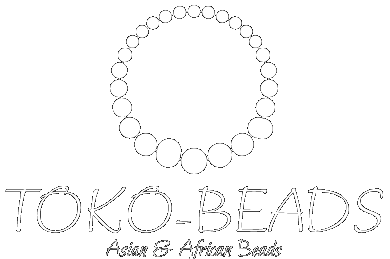Where are Beads from?
Where the beads are made ...

Made in a workshop in tropical Java (Indonesia)
It is a production scene with lampwork at the customer Tonbotama beads studio on Java Island. At first glance, it is a poorly constructed workshop, but it is a "structure" that not only blocks the tropical sun but also has an excellent ventilation function to release the heat of the burner and work comfortably. Most of Java's dragonfly balls are handmade one by one in such an environment, so there are slight variations in size and shape. I used to take a sample of Javanese dragonfly balls and show it to a Chinese bead maker. "If you make something like this in China, it's said to be defective. Japanese people who send precision products to the world I've been asked, "Why do you want to make something like this?", But even if I explain that some people like this unevenness, it's hard to understand.The president of this Java bead studio was originally a bead production craftsman who worked like the image, so even now, if you ask for a prototype of a custom-made product, you can make it yourself in no time.

Indian beads situation
As far as I know, there is no strict definition for the so-called "Indian beads", but many designs that strongly impress the "values" that are unique to India are produced. Produced with elaborate techniques in every detail of the design, there is little variation in size, color tone and shape, and even though it is handmade, it shows a "beautiful" finish with handmade glass beads from other Asian countries. Is a big difference. However, one of the features is that the minimum number of products that can be produced per design (same design and same color) is large. Previously, I tried to cover the production site, but I couldn't get any guidance.Wood beads workshop in the Philippines
Guided by the president's wife who picked me up at the hotel on the island, when I climbed the mountain slope of the palm forest in the suburbs, there was a "factory" in a slightly open place. Around the factory, there is a house where bead craftsmen can finish, and children are running around energetically. As you can see, using a simple power tool, cutting out the prototype from wood, shaping, drilling, polishing, and surface treatment are all done by hand. The finished product is beautiful and smooth to the touch, and the wood beads of this manufacturer, which are completed only with the color tone of the uncolored material, are unparalleled.
Kenyan Kazuri beads
Kazuri is a pottery bead that is hand-produced in a large factory in Nairobi, Kenya. It is said to be run by a Danish company and is basically sold only as a designed and assembled accessory. Kazuri is a Swahili word that means "small and beautiful." The factory is lined with work desks, and employees work brightly in a clean room. Since it is a pottery bead, it is lightweight for its size and is ideal for accessories. The laid-back, dry design that is typical of Africa is very attractive.
